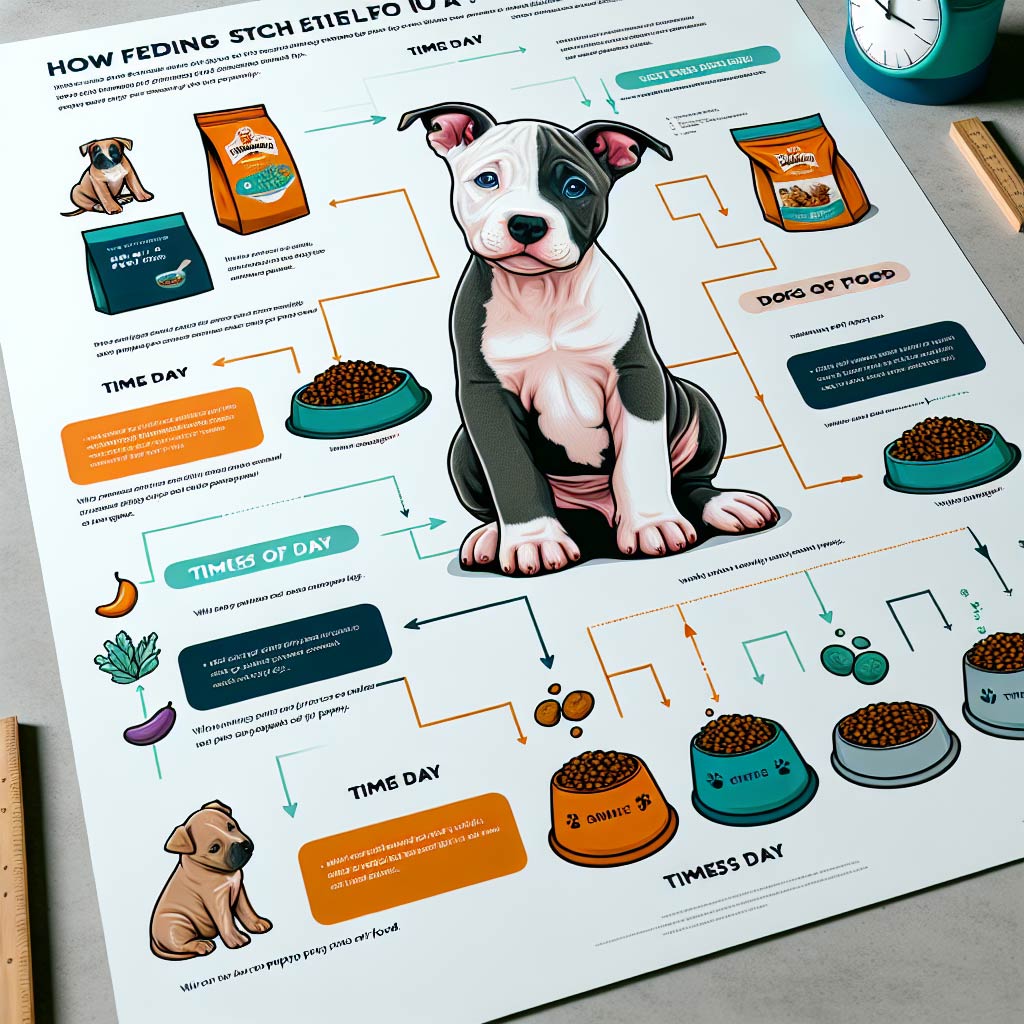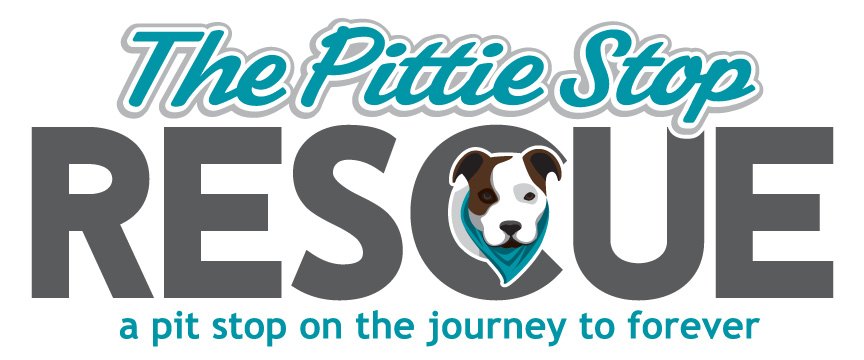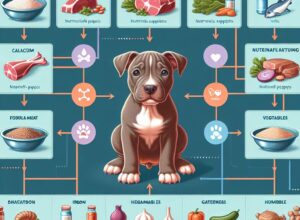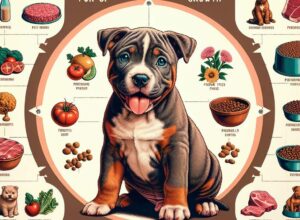
Feeding Your Pitbull Puppy for Long-term Wellbeing
As a proud Pitbull puppy owner, you want nothing but the best for your furry friend. Ensuring they grow up healthy and strong is a top priority, and it all starts with what’s in their food bowl. Let’s talk about how to nourish your pup, not just fill their belly.
Key Takeaways
Before we jump into the details, here’s what you need to remember:
- Consistent feeding times help your Pitbull puppy develop a reliable routine.
- Quality over quantity: Pick nutrient-rich foods that support healthy growth.
- Adjust meal frequency as your puppy grows to avoid over or underfeeding.
- Protein is key for muscle development, but balance it with other nutrients.
- Regular vet check-ups will keep you on track with your puppy’s dietary needs.
Nutritional Cornerstones for Pitbull Puppies
When it comes to feeding your Pitbull puppy, think of their diet as the foundation of their future health. A balanced diet with the right mix of proteins, fats, carbohydrates, vitamins, and minerals is essential. This balance supports everything from their playful energy to their shiny coat and strong bones.
Remember, your Pitbull puppy is not just a smaller version of an adult dog; they have unique dietary needs that change as they grow. It’s crucial to give them food specifically formulated for puppies, which has the right nutrients to support their development.
Meal Frequency: Tailoring to Your Puppy’s Growth Stage
Meal frequency is a game-changer for your Pitbull puppy’s growth. Young pups need small, frequent meals throughout the day to maintain their energy levels and support their rapid growth. As they grow older, you can gradually decrease the number of meals while increasing the portion sizes.
Here’s a quick guide to meal frequency based on age:
- Under four months: Four meals a day
- Four to six months: Three meals a day
- Over six months: Two to three meals a day
Sticking to this schedule helps prevent blood sugar dips and ensures your puppy is getting the nutrients they need when they need them most.
Decoding Pitbull Puppy Nutritional Needs
Understanding the nutritional needs of your Pitbull puppy is like unlocking the secret to their optimal health. Each nutrient plays a specific role in their body, and getting the balance right is crucial for their overall wellbeing.
Protein: Building Blocks of Muscle
Protein is the cornerstone of a Pitbull puppy’s diet. It’s what builds their muscles, repairs tissues, and keeps their immune system strong. High-quality protein sources like chicken, beef, or fish should be at the top of your ingredient list when selecting food for your pup.
But how much protein is enough? Aim for a diet that consists of at least 22% protein for puppies. This will ensure they’re getting enough to support their growth without overloading their system. Always check the food label to confirm the protein content and make sure it’s coming from good sources.
Remember, while protein is important, it’s not the only nutrient your Pitbull puppy needs. Next, we’ll look at how fats and carbohydrates also play a vital role in your puppy’s diet.
Fats and Carbohydrates: Sustained Energy for Playtime
Fats are more than just a source of energy for your Pitbull puppy; they’re essential for healthy skin, coat, and brain development. Look for foods with good fat sources like fish oil, which provides omega-3 fatty acids crucial for cognitive development. Carbohydrates, on the other hand, should come from complex sources like sweet potatoes and brown rice, providing steady energy for your puppy’s play and exploration.
While fats are calorie-dense and provide a lot of energy, balance is key. Too much fat can lead to unwanted weight gain, so it’s important to follow recommended guidelines on the amount of fat in your puppy’s diet. Typically, puppy food should contain between 8-15% fat.
Vitamins and Minerals: For Healthy Development
Vitamins and minerals might not be the first thing you think of when planning your puppy’s diet, but they’re indispensable. They support bone growth, nerve function, and even help with blood clotting. Calcium and phosphorus need to be in the right ratio for strong bone development, while vitamins like A, E, and C support the immune system and vision.
Always choose a puppy food that’s fortified with essential vitamins and minerals. This ensures your Pitbull puppy isn’t missing out on these vital nutrients for their overall health and development.
Creating a Feeding Timetable
Consistency is comforting for puppies. A feeding timetable not only helps regulate their digestion but also instills a sense of security. A consistent feeding schedule also makes house training easier, as puppies typically need to relieve themselves shortly after eating.
8-12 Weeks Old: Essential Starting Point
When your Pitbull is 8-12 weeks old, they’re at a critical growth phase. They should be eating four times a day, with meals evenly spaced throughout the day. This is when they’re transitioning from their mother’s milk to solid food, so it’s important to choose a high-quality puppy formula that’s easy to digest.
At this stage, your puppy’s stomach is still small, so keep portions manageable. The exact amount will depend on the food you’re using and your puppy’s size, but generally, a quarter to a half cup of food per meal is appropriate.
3-6 Months: Transitioning as They Grow
As your Pitbull puppy grows, their stomach capacity increases, allowing for fewer but larger meals. By the time they’re 3-6 months old, you should be feeding them three times a day. Keep monitoring their growth and adjust portions as needed. It’s crucial not to overfeed during this stage to prevent rapid weight gain, which can lead to health issues.
During this period, your puppy will be teething, so they might become pickier with their food. Be patient and keep meal times positive and stress-free.
6-12 Months: Preparing for Adulthood
As your Pitbull approaches their first birthday, you’ll start to see signs that they’re ready for adult food. This transition should be gradual, mixing in adult food with their puppy formula over several weeks. By 12 months, most Pitbulls can be switched to two meals a day.
During this time, keep an eye on their body condition and adjust their diet accordingly. If they’re looking a bit too round, cut back on the portions; if they’re too lean, they might need a bit more.
Remember, every puppy is unique, and their needs can vary. Regular check-ups with your vet will help ensure your feeding timetable is on point for your Pitbull’s individual growth and health needs.
Avoiding Common Pitfalls in Puppy Feeding
Feeding your Pitbull puppy might seem straightforward, but there are a few traps you’ll want to sidestep. These pitfalls can disrupt your puppy’s growth and lead to health issues down the line. Let’s make sure you’re equipped to dodge these common mistakes.
Understanding Portion Sizes
Portion control is a big deal. Too little and your puppy might not get the energy they need to grow; too much and you risk obesity. The right amount depends on the puppy’s age, weight, and the type of food you’re using. Follow the guidelines on the puppy food packaging as a starting point, and adjust as needed based on your puppy’s appetite and body condition.
Here’s a tip: use a measuring cup for your puppy’s food. Guessing can lead to overfeeding, and what looks like a small amount can be too much for a little stomach.
Balancing Treats and Meals
Treats are great for training and bonding, but they should never be more than 10% of your puppy’s daily calorie intake. It’s easy to get carried away, especially when those puppy eyes are looking up at you, but stay strong. Use small, healthy treats and always account for them in your puppy’s daily food allowance.
Remember, treats are a supplement to, not a substitute for, balanced meals. Keep them in their place, and your puppy will thank you with good health and vitality.
Recognizing and Preventing Obesity
Obesity is as dangerous for puppies as it is for humans. It can lead to a host of health problems, including joint issues, diabetes, and heart disease. Keep an eye on your Pitbull’s body shape; you should be able to feel their ribs without a thick layer of fat, and they should have a visible waist when viewed from above.
If you’re concerned about your puppy’s weight, consult your vet. They can help you adjust your feeding plan and recommend an exercise routine to get your pup back in tip-top shape.
Tips for Optimizing Your Pitbull’s Feeding Schedule
Every Pitbull puppy is unique, and their feeding schedule should be too. Here are some tips to make sure your puppy’s feeding routine is tailored perfectly to their needs.
Adapting to Your Pitbull’s Activity Levels
Pitbulls are known for their energy and playfulness, and your puppy’s diet should reflect their activity level. More active puppies may need more calories to keep up with their energy expenditure. On the flip side, if your puppy is more of a couch potato, they might need fewer calories to avoid weight gain.
Keep a close eye on how much your puppy plays and exercises, and talk to your vet about adjusting their diet to match their lifestyle. It’s all about finding that sweet spot where they have the energy they need without overeating.
Remember, your Pitbull’s activity levels can change quickly as they grow, so be prepared to adapt their feeding schedule accordingly. Regular playtimes and walks will help you gauge their energy needs and keep them healthy and happy.
Building a Routine Around Your Schedule
Let’s be real, life is hectic. But when it comes to feeding your Pitbull puppy, consistency is key. A regular feeding routine keeps your pup’s metabolism stable and helps with house training. So, how do you make it work with your busy life? It’s all about creating a schedule that fits both your needs.
Start by looking at your daily routine. Identify times that you’re usually at home and can give your puppy their meals. Mornings before work, evenings after you get back, and a quick stop at lunch can become your go-to feeding times. If your schedule is unpredictable, consider an automatic feeder that dispenses food at set times.
Stick to these times as closely as possible. Yes, there will be days when things don’t go to plan, but don’t sweat it. Just get back on track as soon as you can. Your puppy will adapt to the routine you set, and it’ll make both of your lives easier.
Staying Informed on Pitbull Health and Diet Trends
Like with any aspect of health, knowledge is power. The world of pet nutrition is always evolving, and staying up-to-date on the latest Pitbull health and diet trends can help you make informed decisions for your puppy’s wellbeing.
Subscribe to reputable pet health blogs, join Pitbull owner forums, and don’t hesitate to ask your vet questions. They can provide valuable insights into what’s new and what’s actually beneficial for your puppy. Plus, they can debunk any myths that might lead you astray.
Remember, not every trend is right for every puppy. What works for one Pitbull might not work for yours. Always consider your puppy’s individual needs before jumping on the bandwagon of the latest diet fad.
FAQ
How many times a day should I feed my pitbull puppy?
Feeding frequency for your Pitbull puppy changes as they grow. Here’s a quick breakdown:
- Under four months old: Four meals a day.
- Four to six months old: Three meals a day.
- Over six months old: Two to three meals a day.
These meals should be evenly spaced out to keep your pup’s energy levels consistent throughout the day.
What should I feed my pitbull puppy?
Choosing the right food for your Pitbull puppy is crucial. Go for high-quality puppy food that’s rich in protein and has the right balance of fats, carbohydrates, vitamins, and minerals. Here’s what to look for:
- Protein sources like chicken, beef, or fish as the first ingredient.
- A balance of omega-3 and omega-6 fatty acids for brain and coat health.
- Essential vitamins and minerals to support overall growth.
- No fillers, artificial colors, or preservatives.
Always check with your vet for specific recommendations, especially if your puppy has unique health needs.
How do I know if I’m overfeeding my pitbull puppy?
Overfeeding can be a common mistake, but it’s one you’ll want to avoid. Here’s how to tell if your puppy might be getting too much food:
- They’re gaining weight rapidly and are above the recommended weight for their age and breed.
- You can’t easily feel their ribs under a layer of fat.
- They lack a visible waist when you look at them from above.
- They’re less active or seem lethargic after meals.
If you suspect you’re overfeeding, consult your vet. They can help you adjust your puppy’s diet and get them back to a healthy weight.
Can I give my pitbull puppy adult dog food?
It’s a question many puppy parents ask, and the answer is critical for your Pitbull’s growth. Adult dog food lacks the essential nutrients in the precise amounts that a growing puppy needs. Puppies require more protein, amino acids, and certain vitamins and minerals to support their rapid development. Feeding them adult dog food can lead to malnutrition and affect their growth.
Stick with high-quality puppy food until your vet advises you to transition to adult food. This usually happens around the one-year mark but can vary depending on the breed and individual growth rate of your puppy.
When you do start the switch, make the transition gradually over a week or two, mixing in increasing amounts of adult food with the puppy food. This helps prevent digestive upset and allows your puppy’s system to adjust to the new diet.
When should I switch my pitbull puppy to two meals a day?
As your Pitbull matures, their nutritional needs and eating habits will change. Typically, you’ll want to switch to two meals a day when they’re about six months old. However, larger breeds may benefit from staying on three meals a day a bit longer. This is because they continue to grow and need the extra nutrients and energy that an additional meal provides.
Watch your puppy’s behavior and body condition closely. If they’re leaving food behind at meal times or seem disinterested in one of their meals, it might be time to reduce the frequency. Always consult with your vet to determine the best timing for this transition, as they can provide guidance based on your puppy’s specific health and growth needs.
In conclusion, raising a healthy Pitbull puppy is a rewarding journey that requires attention to detail, especially when it comes to their diet. A well-planned feeding schedule, tailored to their growth stages, sets the foundation for a lifetime of health and happiness. Keep these tips in mind:
- Feed your Pitbull puppy age-appropriate food and follow the recommended meal frequencies.
- Monitor their growth and adjust their diet as needed, with guidance from your vet.
- Transition to adult food and reduce meal frequency gradually, based on their development.
- Stay informed and proactive about your puppy’s nutritional needs.
- Most importantly, enjoy every moment with your growing Pitbull—they’ll be all grown up before you know it!
With love, patience, and the right nutrition, your Pitbull puppy will thrive. Here’s to a future filled with wagging tails, playful barks, and a strong, healthy companion by your side!



